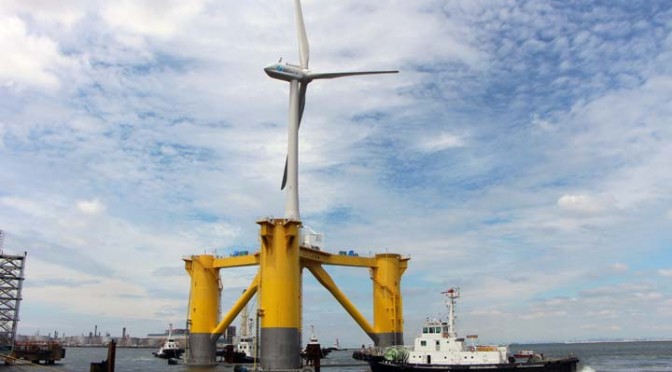With the financing in place for Japan’s first large-scale commercial wind farm project, the country is looking to follow in the footsteps of Taiwan and accelerate its transition to renewable energy sources.
The world’s third largest economy is aiming to boost the renewables share of its energy mix from 16% to 24% by 2030, with hydropower contributing 9.2%, solar 7%, biomass 4.6%, wind 1.7%, and geothermal 1.1%.
Marubeni Corporation, through a special purpose company called Akita Offshore Wind Corporation, has decided to implement the construction, operation and maintenance of offshore wind farms at the Akita and Noshiro ports in Akita prefecture.
The 100-billion-yen (US$894.40 million) project will create about 140 megawatts of electric power to be sold to Tohoku Electric Power over 20 years under a power purchase agreement based on the feed-in-tariff programme. The project is expected to commence commercial operations in 2022, with the base for operations and maintenance at the Noshiro port.
“This is an important project as it can serve as a template in the development of the sector going forward,” says Daniel Mallo, managing director and head of natural resources and infrastructure for Asia-Pacific at Societe Generale CIB, which acted as a senior lender in the transaction. “The project also demonstrates the spread of offshore wind farming is beginning to happen across the region.”
The loan agreements for the project were concluded on February 3, and the funding was provided by multiple domestic and foreign financial institutions, with MUFG Bank, Mizuho Bank, and Sumitomo Mitsui Banking acting as joint mandated lead arrangers.
In addition to Marubeni, the project sponsors include Obayashi Corporation, Tohoku Sustainable & Renewable Energy , Cosmo Eco Power, Kansai Electric Power , Chubu Electric Power , Akita Bank, Ohmori Company, Sawakigumi Corporation, Kyowa Oil , Katokensetsu Company, Kanpu Company and Sankyo Company.
Japan, unlike some other countries, is constrained in its ability to substantially scale up onshore wind farm and solar projects because it has a high population density and its topography is not conducive to building these projects.
“So, for Japan to accelerate its energy transition to renewables, which was initially driven through solar farm projects, offshore is a good way to go,” Mallo points out. However, while Japan is land-constrained, it has a lot of coastline, which allows offshore wind farm projects to be significantly bigger than those that can be built onshore.
Mallo says the long-term potential for offshore wind farm development in Japan is much greater than in Taiwan, which is aiming to install 5.5 gigawatts of offshore wind farm capacity by 2025. Japan has a lot of strong domestic sponsors, who are active investors in the energy and power sector. Marubeni, for instance, is an active investor in offshore wind farming in Europe, and already has a lot of project expertise. In addition, a large amount of domestic capital is available to fund offshore wind farm projects.
While the Marubeni project involves only Japanese sponsors, foreign sponsors are highly interested in the project due to its huge potential and the fact that Japan is an attractive and highly-rated investment space. “Similar to the Taiwan story, these foreign sponsors are looking for new growth markets and that’s what will draw them to Japan as well,” notes Mallo.
Going forward, the next frontier for the Japanese wind farm sector will be floating wind farms as Japan is surrounded by deep seabeds. And, according to Mallo, there is interest among investors in Japan to sponsor such projects.
Japanese authorities have also made a strong push to develop the offshore wind farm power sector by addressing regulatory issues, such as the terms of concessions. A bill passed in November 2018 allows a maximum occupancy period of 30 years for offshore wind farms in the so-called promotion zone. This was a welcome development from the short-term occupancy rights previously granted by local prefectures.
The government is also offering a relatively generous feed-in tariff to kickstart the industry and attract initial investors, although it is expected that the tariff – similar to the one given to the solar power sector – will decline over time as the industry grows and achieves economies of scale.
This year, Japan is also launching a competitive tender for offshore wind farming to generate more investor interest.
theasset.com


